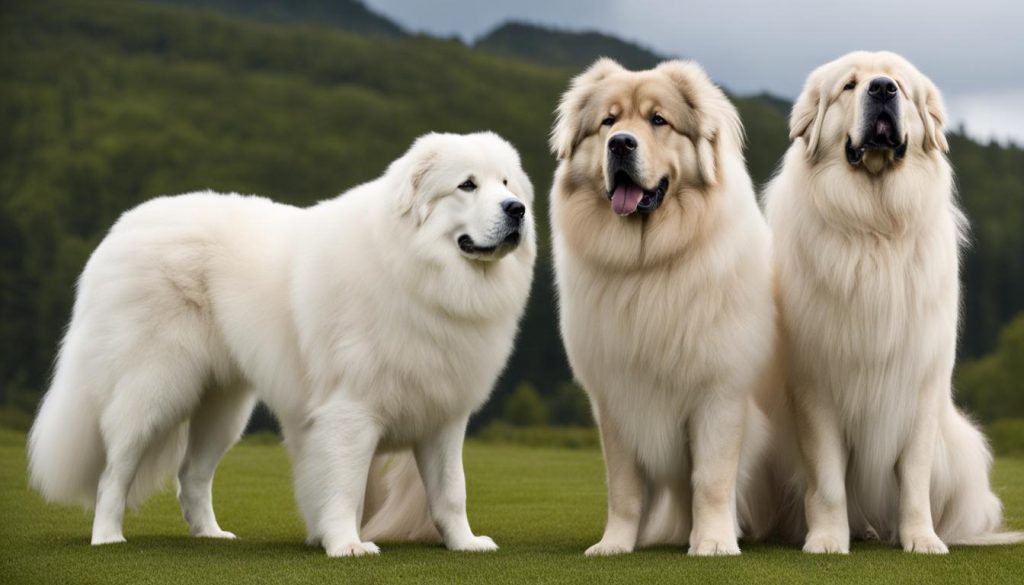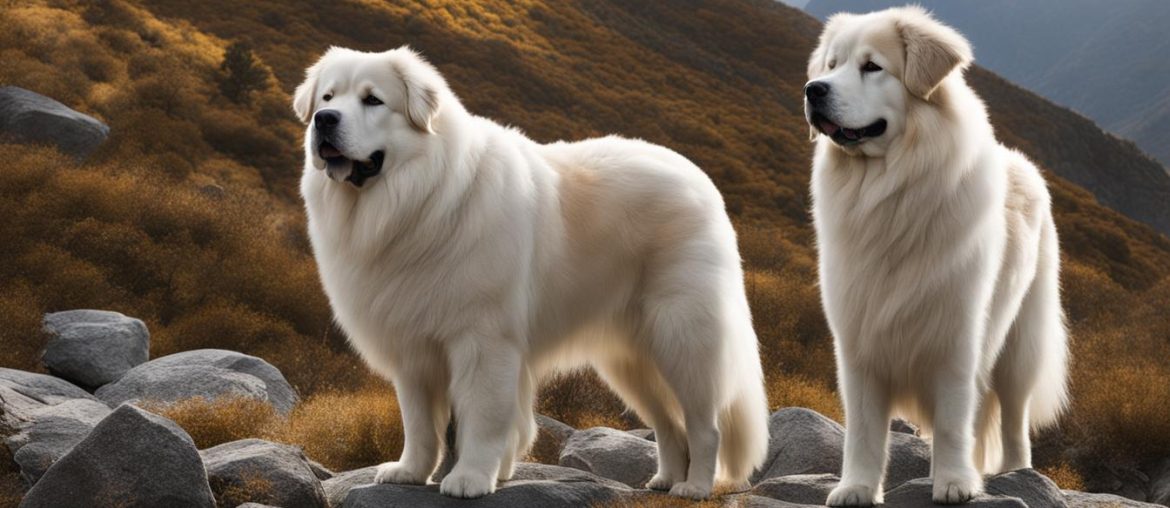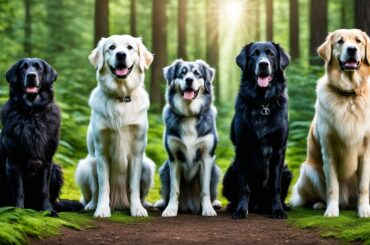In this article, I will compare the characteristics of two majestic dog breeds: the Tibetan Mastiff and the Great Pyrenees. While these breeds share some similarities, they also have distinct differences that make them unique. Understanding these variations is essential for prospective owners to make an informed decision about which breed is the right fit for them.
When comparing the Tibetan Mastiff and Great Pyrenees, it is essential to consider factors such as temperament, size, exercise needs, grooming requirements, health, adaptability, social needs, and barking tendencies. By examining these aspects, we can gain a comprehensive understanding of what each breed brings to the table.
Key Takeaways
- The Tibetan Mastiff and Great Pyrenees have different temperaments and personalities.
- Both breeds are large, but the Great Pyrenees tends to be slightly taller.
- Tibetan Mastiffs and Great Pyrenees have low to moderate exercise needs.
- Grooming requirements for both breeds are similar, with regular brushing being essential.
- Health issues such as hip dysplasia can affect both breeds, requiring regular vet check-ups.
Temperament and Personality
When comparing the temperament and personality of the Tibetan Mastiff and the Great Pyrenees, you should understand the unique traits that each breed possesses.
Temperament:
The Tibetan Mastiff is known for its independent and aloof nature. While they are fiercely loyal and loving towards their family, they can be wary of strangers. Without proper socialization, Tibetan Mastiffs may exhibit aggression towards unfamiliar people or animals. On the other hand, Great Pyrenees are confident and affectionate. They are known for their patient and gentle nature, which makes them excellent companions for children.
Personality:
Tibetan Mastiffs are introverted and tend to be more reserved. They form a strong bond with their family and view themselves as equals. Their protective instincts are highly developed, making them excellent guardians. Great Pyrenees, on the other hand, are more social and enjoy the company of their family and other animals. They may have a more welcoming approach towards strangers, but they also have a strong protective instinct.
Both breeds require early socialization to ensure they grow up to be well-rounded and well-behaved dogs. I would recommend to provide them with training, consistent boundaries, and positive reinforcement to bring out the best in their temperament and personality.

| Breed | Temperament | Personality |
|---|---|---|
| Tibetan Mastiff | Independent and wary of strangers | Loving and loyal to family, protective |
| Great Pyrenees | Confident and affectionate | Patient and gentle, protective |
Size and Weight
When comparing the Tibetan Mastiff and the Great Pyrenees, size is an important factor to consider. Both breeds are large, but there are slight differences in their measurements. The Tibetan Mastiff typically stands at a height of 24-26 inches, while the Great Pyrenees is slightly taller, ranging from 27-32 inches. In terms of weight, the Tibetan Mastiff weighs between 100-170 pounds, while the Great Pyrenees weighs around 85-160 pounds. It’s worth noting that individual dogs may vary within these ranges.
In order to visualize the size comparison between the two breeds, here is a table showcasing their average height and weight:
| Breed | Height (inches) | Weight (pounds) |
|---|---|---|
| Tibetan Mastiff | 24-26 | 100-170 |
| Great Pyrenees | 27-32 | 85-160 |
As seen in the table, the Great Pyrenees tends to be slightly larger in terms of both height and weight compared to the Tibetan Mastiff.
Growth and Development
both breeds have a relatively slow growth rate and may take longer to reach their full size. Proper nutrition, exercise, and regular vet check-ups are crucial during their development to ensure they grow into healthy and well-proportioned adults.
As with any dog, consider the size and weight requirements of the Tibetan Mastiff and the Great Pyrenees when considering them as pets. Make sure you have adequate space, both indoors and outdoors, to accommodate their size and provide them with a comfortable living environment.
Exercise and Activity Needs
When it comes to exercise requirements, both the Tibetan Mastiff and Great Pyrenees have relatively low to moderate needs. While they do not require intense physical activity, regular exercise is still important for their overall health and well-being.
The Tibetan Mastiff benefits from daily walks and mental stimulation to keep them physically and mentally engaged. They are not typically suited for high-intensity activities or endurance sports but enjoy leisurely walks and playtime.
Similarly, the Great Pyrenees also has low to moderate exercise needs. They are a calm and laid-back breed that enjoys walks and playtime but does not require excessive physical activity. They are content with a moderate exercise routine.
Neither breed is suited for high-intensity activities or endurance sports. They thrive in an environment that provides a balance of physical and mental stimulation without overly strenuous exercise.

Exercise and Activity Needs Comparison
| Tibetan Mastiff | Great Pyrenees | |
|---|---|---|
| Exercise Requirements | Low to moderate | Low to moderate |
| Ideal Activities | Daily walks, mental stimulation | Leisurely walks, playtime |
| Suitability for High-intensity Activities | Not suitable | Not suitable |
| Suitability for Endurance Sports | Not suitable | Not suitable |
Grooming Requirements
Proper grooming is essential for both Tibetan Mastiffs and Great Pyrenees to maintain the health and appearance of their luxurious coats. While both breeds have medium grooming needs, the Tibetan Mastiff is generally easier to groom compared to the Great Pyrenees.
Tibetan Mastiffs have a thick double coat that requires regular brushing to prevent matting and shedding. Their dense fur provides insulation and protection, making them well-suited for harsh climates. Regular bathing and nail trimming are also important aspects of their grooming routine.
Great Pyrenees have a similar coat to the Tibetan Mastiff, with a thick undercoat and longer outer coat. They also require regular brushing to prevent tangles and mats. However, Great Pyrenees may need more frequent grooming due to their tendency to shed heavily, especially during the change of seasons.
| Grooming Needs | Tibetan Mastiff | Great Pyrenees |
|---|---|---|
| Coat Type | Double coat | Double coat |
| Brushing Frequency | Regular brushing to prevent matting and shedding | Regular brushing to prevent tangles and mats, may need more frequent grooming due to heavy shedding |
| Bathing | Regular bathing as needed | Regular bathing as needed |
| Nail Trimming | Regular nail trimming | Regular nail trimming |
Proper grooming not only keeps their coats looking beautiful but also promotes overall skin health and hygiene. You should establish a grooming routine early on to ensure that both breeds are comfortable with the process. Seeking professional grooming help can also be beneficial, especially for maintaining their large size and managing any specific grooming challenges.
Health and Lifespan
When considering the health and lifespan of Tibetan Mastiffs and Great Pyrenees, you should be aware of potential health issues that may affect both breeds. Tibetan Mastiffs have a lifespan of 10-14 years, while Great Pyrenees typically live between 10 to 12 years.
Tibetan Mastiffs are prone to certain health conditions, including hip dysplasia and autoimmune hypothyroidism. These conditions can affect their mobility and overall well-being. Regular veterinary check-ups, a balanced diet, and providing proper exercise can help mitigate these risks and ensure a healthy life for your Tibetan Mastiff.
Similarly, Great Pyrenees are also susceptible to health issues such as hip dysplasia and patellar luxation. These conditions can cause pain and discomfort for the dog. You should monitor their weight, provide regular exercise, and seek veterinary care when necessary to manage these conditions effectively.
Both breeds should receive regular preventive care, such as vaccinations and parasite control, to maintain their overall health and well-being. You might want to consult with a veterinarian to establish a preventative healthcare plan that suits the specific needs of your dog.

Comparison of Health and Lifespan
| Breed | Lifespan | Common Health Issues |
|---|---|---|
| Tibetan Mastiff | 10-14 years | Hip Dysplasia, Autoimmune Hypothyroidism |
| Great Pyrenees | 10-12 years | Hip Dysplasia, Patellar Luxation |
Adaptability and Living Environment
When considering the adaptability of Tibetan Mastiffs and Great Pyrenees, it is essential to examine their ability to adjust to different living environments. While both breeds have their unique characteristics, they may have different living requirements that potential owners should consider.
Tibetan Mastiffs have an average level of adaptability and can adjust reasonably well to various living situations. However, due to their size and exercise needs, they may not be the best fit for apartment living. These majestic dogs require ample space to roam and a secure yard to ensure their physical and mental well-being. Therefore, a home with a spacious yard or access to open areas would be ideal for a Tibetan Mastiff.
On the other hand, Great Pyrenees are known for their adaptability to different living environments. While they can thrive in urban settings such as apartments or houses with small yards, they still require ample space to roam and play. You should note that Great Pyrenees have a strong instinct to protect their territory, so a secure and fenced yard is necessary to prevent them from wandering off.
Ultimately, the decision on which breed is more suitable for a particular living environment depends on various factors, including space availability, access to outdoor areas, and the commitment of the owner to provide the necessary exercise and mental stimulation for their canine companion.
Giving Your Dog the Perfect Living Environment
Creating a suitable living environment for your dog involves more than just providing a space for them. It requires understanding their specific needs and catering to them accordingly. Here are some key considerations:
- Space: Ensure that you have enough room to accommodate your dog’s size and activity level. A spacious yard or access to outdoor areas is beneficial for both breeds.
- Exercise: Both Tibetan Mastiffs and Great Pyrenees require regular exercise to maintain physical and mental well-being. Daily walks, playtime, and mental stimulation are essential.
- Safety: Create a safe and secure environment for your dog, particularly if you have a Tibetan Mastiff or Great Pyrenees. Fenced yards and secure enclosures will prevent them from escaping and keep them protected.
- Socialization: Both breeds can benefit from early socialization to ensure they are comfortable with strangers and other animals. Expose them to different environments, people, and pets from a young age.
- Mental Stimulation: Provide mental enrichment activities such as puzzle toys, training sessions, and interactive games to keep your dog mentally engaged and prevent boredom.
By considering these factors and providing a suitable living environment, you can ensure that your Tibetan Mastiff or Great Pyrenees is happy, healthy, and thriving in their surroundings.
Social Needs and Interaction
When considering the social needs and interaction of Tibetan Mastiffs and Great Pyrenees, you should understand their unique temperaments and personalities. Tibetan Mastiffs are independent and introverted, often wary of strangers but deeply loyal to their family. They may require proper socialization to prevent aggression towards unfamiliar individuals and other dogs. On the other hand, Great Pyrenees are confident and affectionate, known for their patient and gentle nature. They enjoy the company of their family and other animals, making them more social in comparison to Tibetan Mastiffs.
“Tibetan Mastiffs are independent and aloof, but they are loving and loyal to their family.”
It is worth noting that Tibetan Mastiffs may not readily accept strangers or new dogs, as they have a protective instinct and may view unfamiliar individuals with wariness. This breed’s social needs lean more towards their family members rather than external interactions. Conversely, Great Pyrenees are more welcoming to strangers due to their friendly nature, but their strong protectiveness remains intact. They still prioritize their family’s companionship and seek social interaction with them.
Comparing the Social Needs
Here is a comparison of the social needs of Tibetan Mastiffs and Great Pyrenees:
| Tibetan Mastiffs | Great Pyrenees | |
|---|---|---|
| Social Interaction | Average need | High need |
| Acceptance of Strangers | Less accepting | More accepting |
| Acceptance of New Dogs | Less accepting | More accepting |
Overall, while both breeds appreciate social interaction, Tibetan Mastiffs typically prioritize their family and may be less welcoming to strangers or unfamiliar dogs. Great Pyrenees, on the other hand, have a higher need for social interaction, enjoying the company of both their family and other animals. I recommend that you provide a suitable social environment for each breed, considering their unique needs and temperaments.

Barking Tendency
When it comes to barking tendencies, both the Tibetan Mastiff and the Great Pyrenees have their distinct characteristics. The Tibetan Mastiff has an average level of barking, using their voice to alert their owners to potential threats or intruders. They are known to be vocal and take their guarding duties seriously, making them excellent watchdogs. However, with proper training and socialization, they can learn to differentiate between real threats and everyday noises.
On the other hand, the Great Pyrenees is known to bark more frequently than the Tibetan Mastiff. This breed has a strong protective instinct and uses their voice to communicate and ward off potential dangers. Their bark can be deep and booming, making it an effective deterrent. While their barking can be beneficial for protecting their territory, it’s essential for owners to provide proper training to prevent excessive barking, especially in urban environments where noise levels need to be considered.
Overall, both breeds have a tendency to use their voice as a warning signal. Their barking tendencies can be managed through consistent training, socialization, and providing them with appropriate outlets for their energy and protective instincts.
Table: Comparison of Barking Tendency
| Breed | Barking Tendency |
|---|---|
| Tibetan Mastiff | Average level of barking, uses voice as an alert |
| Great Pyrenees | Barks more frequently, strong protective instinct |
Final Thoughts
After comparing the Tibetan Mastiff and Great Pyrenees, it is clear that both breeds have their unique characteristics and qualities. When considering which breed is right for you, you should take into account their temperament, size, exercise needs, grooming requirements, health, adaptability, social needs, and barking tendencies.
The Tibetan Mastiff is an independent and loyal breed, known for its strong guarding instincts and protective nature. They require proper socialization to prevent aggression towards strangers and other dogs. With a large size and moderate exercise needs, they excel at guarding livestock but may not be suitable for obedience competitions or agility.
The Great Pyrenees, on the other hand, is a confident and affectionate breed with a patient and gentle nature. They are known for their love of children and their adaptability to different living environments. While they also have strong guarding instincts, they may be more accepting of strangers.
Ultimately, the choice between the Tibetan Mastiff and Great Pyrenees depends on your personal preferences and lifestyle factors. Both breeds can make loyal and protective companions, but you should choose the one that best aligns with your needs and expectations.
FAQ
Are Tibetan Mastiffs aggressive?
Tibetan Mastiffs can be wary of strangers and may exhibit aggression without proper socialization.
Can Tibetan Mastiffs get along with children and other pets?
Tibetan Mastiffs can be trained to get along with children and other pets when raised with them, but may be less accepting as adults.
Are Great Pyrenees good with children?
Yes, Great Pyrenees are known for their patient and gentle nature, making them great with children.
What are the exercise requirements for Tibetan Mastiffs?
Tibetan Mastiffs have low to moderate exercise needs and benefit from daily walks and mental stimulation.
What are the exercise requirements for Great Pyrenees?
Great Pyrenees also have low to moderate exercise needs and enjoy walks and playtime.
How often should Tibetan Mastiffs be groomed?
Tibetan Mastiffs have medium grooming needs and require regular brushing to prevent matting and shedding.
How often should Great Pyrenees be groomed?
Great Pyrenees have similar grooming needs and also require regular brushing, but may need more frequent grooming due to shedding.
What are the common health issues for Tibetan Mastiffs?
Tibetan Mastiffs may be prone to health issues such as hip dysplasia and autoimmune hypothyroidism.
What are the common health issues for Great Pyrenees?
Great Pyrenees may also experience health issues like hip dysplasia and patellar luxation.
Can Tibetan Mastiffs adapt to apartment living?
While Tibetan Mastiffs have average adaptability, they may not be suitable for apartment living due to their size and exercise needs.
Can Great Pyrenees adapt to apartment living?
Great Pyrenees adapt well to different living environments but are not recommended for apartment living due to their need for space.
Are Tibetan Mastiffs social dogs?
Tibetan Mastiffs have an average need for social interaction and tend to prefer their family over strangers or new dogs.
Are Great Pyrenees social dogs?
Great Pyrenees are social dogs and enjoy the company of their family and other animals.
Do Tibetan Mastiffs bark a lot?
Tibetan Mastiffs have an average level of barking.
Do Great Pyrenees bark frequently?
Yes, Great Pyrenees are known to bark frequently and have a tendency to alert their owners to potential threats or intruders.






